Owner Review: Ford GT vs. Carrera GT
#1
OWNER REVIEW: FORD GT vs. PORSCHE CARRERA GT

As a wise man once said, ďI've spent a bunch of money on cars. The rest has been wasted.Ē With that truism ringing in my head, I was recently fortunate to find an immaculate and virtually new Porsche Carrera GT. I bought the car from Shelby Smith (Elite Autos), an A+ purveyor of spotless GTs and other desirable exotics. The CGT is a car that has always fascinated me, but I was intimidated by its nosebleed price. When it became obvious that the cars were not getting any cheaper, compounded with the fact that this particular example came from the careful and very selective Shelby, I took the plunge. I have now driven it nearly one thousand miles. I warn the good reader in advance that this self-indulgent, vocabulary intensive review may result in a serious case of MEGO (scientific acronym for My Eyes Glazed Over). Remember, no one is forcing you to read this; if you hate all the talk, just nod and look at the pretty pictures.
Some of you who frequent the GT Forum know that this is not my first comparative review of the GT. This one, however, focuses on a contender that swings a very big stickÖand in this case itís made of carbon fiber. My standard pledge applies: Iíll try to be as honest and fair as I know how to be.
Intro: The Porsche Carrera GT.

Full disclosure: I have a fondness for Porsches, and the Carrera GT is my sixth car from the elves in Stuttgart. I presently have a 2013 Carrera 4S (7 speed manual) that is pure bliss to drive. My first real sports car was a 1984 911 Carrera, which I owned in college, and it sparked a long -term romance with these German icons. It also formed a foundation for how I judge and interpret the subsequent sports cars I have owned.
Ah, the lovely Carrera GT. Based on an aborted Le Mans effort, the body and structural monocoque is made almost entirely of carbon fiber. No cosmetic touches of carbon here, like the laughable $12,000 "carbon package" on the dash of my Ferrari 458. The car sports a pushrod suspension and inboard mounted shock absorbers, which is incredibly cool for a street car. The engine is a 5.7 Liter V-10, which was allegedly developed for Formula 1. The engine was then shelved for later use in either the Le Mans project, or as it turned out, for a limited run super car. Porsche built the CGT in very limited numbers: 1200 or so were assembled, and only half that number came to 'merica. Until I bought mine, I don't think Iíd ever actually seen one on the road. Produced at the same time as the Ford GT, the Carrera GT is also among the last of the true analogue supercars, with a manual transmission and relatively limited computer intervention.
Porsche did not name the Carrera GT by coincidence; it has obvious genetic ties to the revered 911 Carrera, including iconic design elements (the nose for example) and the intimacy of the interior and driving position. The car has a shallow dash, and the windscreen is relatively close to the driver. The moment you sit in the car, the bottom-hinged pedals, the design of the gauge cluster, and the placement of the wheel tell you that youíre in a Porsche. Itís just all about ten times more intense. Imagine taking three or four recent 911s, say, a turbo, a C2S, a 4.0 RS, and maybe even a GT3 Cup car. Further imagine putting these cars into a magical pressing device, and compacting them until a few tiny drops of highly enriched Teutonic mojo drips out the bottom. This is what the CGT is made of. For crying out loud, the whole car is made of carbon fiber, and then they strapped this manic, howling F1-derived V10 into the back of it.
Intro: The Ford GT (For non-owners and neophytes)
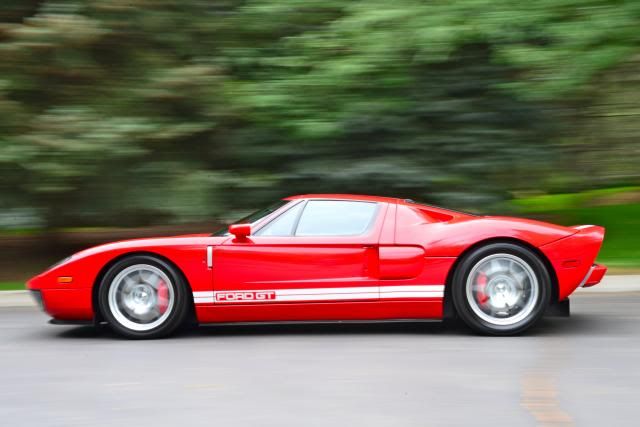
Ford built the GT to commemorate Ford's 100th anniversary, and production ran only in 2005 and 2006. During that time, just over 4000 were built. The car is based on the original GT40, variations of which famously dominated Le Mans from 1966-1969. Since production ended, the cars have been increasing in value and are widely recognized as a highly collectible modern exotic. A low mile Heritage car (Gulf themed, blue and orange) recently sold, including buyerís commission, for over $400,000. The GT boasts a wonderfully robust 5.4-liter, dual overhead cam V8 set under a super trick rear clamshell that opens to expose the entire power plant and rear structure of the car. In my humble opinion, the GT has one of the greatest American V8s ever built, and is capable of incredible feats of horsepower when modified. The Ford GT is unlike anything America has ever produced, with the obvious exception of the original GT40. It is the personification of American exuberance, amazing engineering prowess, inspired design, and just a touch of over-the-top excess. I seldom, if ever, see one on the road. It seems that they are becoming more rare as they are either crashed, exported overseas, or closeted away in private collections.
THE OVERALL DRIVING EXPERIENCE
I remember the first time I ever drove a GT. I said to myself ďSelf, this car is surprisingly docile and easy to driveĒ. When I first drove the CGT, I said to myself, ďSelf, this thing is surprisingly violent and difficult to driveĒ. First impressions arenít always right, but in this case, they were. Let me explain.
That #$%@ Clutch!
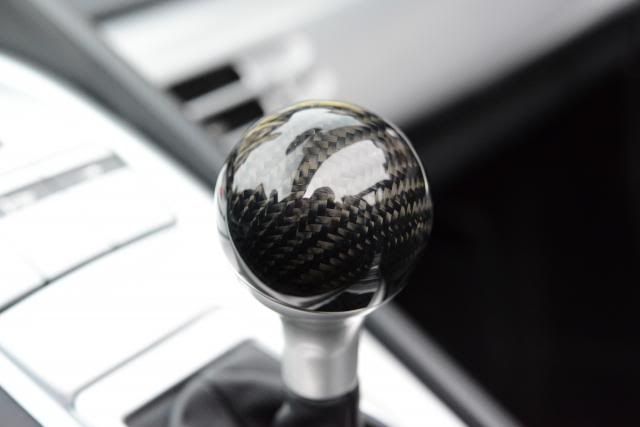
Letís get this out of the way first. Most of you have probably heard reference to the CGTís notorious clutch. Itís a tiny little multi plate affair made of carbon something. It weighs about as much as a pop tart. There is good news here and bad news. First the good: the clutch is quite ordinary and even pleasant to use while the car is in motion (i.e. gears 2-6). The bad news: 1st gear (and only from a dead stop), requires a special procedure that no other car demands. Imagine you are sitting at a stop light in heavy traffic. You are first at the line, because you got there first, just like a sport bike. The light turns green. Your instinct is to feather the throttle downward as you release the clutch, and leave the line smoothly. Bomp. The car bucks and then stalls! You curse. Your face turns red. You fumble. You cast a steely eye toward heaven. The Camry behind you almost tags you in the rump. Your next instinct is to fire the engine, give it even more throttle, and slip the clutch out. If you do this, the clutch will engage like an on/off switch, and you will lurch away from the line with all the grace of a 15 year-old with a learnerís permit. This, I am told, is the reason people burn their CGT clutch up in a few thousand miles and get to pay the price of a nice used car to have it replaced.
The proper method is simple but painfully counterintuitive: keep your foot away from the throttle, release the clutch slowly, and allow the anti-stall software to bump the revs as the car gets rolling. As soon as you are moving, you apply throttle and itís all quite smooth. But boy, does it feel slow. If you live way out in the country like I do, it doesnít matter how quickly you leave a dead stop, and it is an absolute no brainer to drive. Heavy urban traffic, however, is another story. One little trick is to time your start in advance of the green light, or to come to a ďrollingĒ stop at stop signs; if the car is even moving at 2 mph, the clutch is a breeze to release. Here is a word of warning to prospective CGT owner/drivers: if you like to do hole shots out of first gear, either find a different car or buy a six pack of Tilton carbon clutches and make good friends with your banker and your service guy. Iíve tried to figure out why Porsche would sacrifice first gear drivability is such a way. All I can deduce is that they felt quick intersection departures were less important than the ultra light weight and a lower center of gravity. Hmm, sounds suspiciously like a race car. Deal breaker? Not for me. But it might be for someone else.
A Race car in Designer Clothing
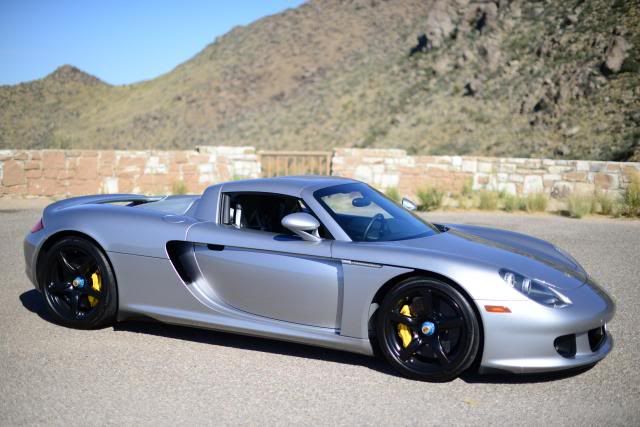
This is where I should digress and make a very important point to the uninitiated: the Carrera GT is certainly not for everyone, and Porsche meant it to be that way. If you look at all the glossy marketing pictures of the CGT and imagine that it will be a velvety, smooth grand touring car like a Mercedes SL, you are utterly and laughably mistaken. The only thing that the Carrera GT has in common with an SL is that they both ride on four wheels, and the only thing that separates the Carrera GT from a full-on race car is the lack of a fuel cell and a fire suppression system. Itís no surprise that it has built-in provisions for a race harness and deeply bolstered track seats, even if they are covered in fine leather.
First, there is the gear noise. In 1st and 2nd gears, there is pronounced sound of the cogs working, and in any gear, at about 2000 rpm, there is a rattlesnake resonance that is quite evident. Where it comes from, I donít know, but it feels like itís in the transaxle. Then thereís the ride, which is transparently communicative of virtually every road imperfection, no matter how tiny. The carbon monocoque has absolutely no flex. Accordingly, every ripple in the road is translated quite accurately through the super sensitive steering and the push rod suspension. As my Dad would say, you could drive over a dime in the CGT and tell the date stamped on it. The road noise is always there too, seemingly amplified by the chassis, and if your ears miss the sound of a every single freeway expansion joint, your bung-o-meter will be happy to send you the memo. Finally, there is the aforementioned race car clutch, the race car acceleration (more on that later) and the light rotational mass of the engine (later too).
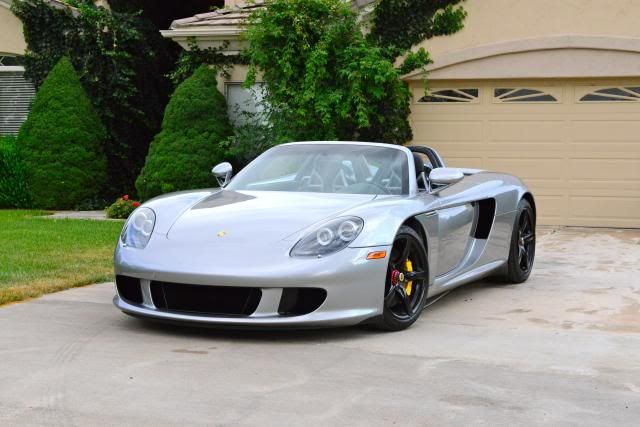
I can certainly imagine that there were at least a few gold Rolex-toting trophy hunters back in Ď05 who bought the CGT, stalled it a few times, crashed it over a speed bump or two, and then escorted it quietly away, like the vulgar cousin who showed up unannounced for tea and crumpets. This is a hairy chested sports car, plain and simple, and I love it. Itís almost as if the design team said, ďokay, if we donít have to mass market this thing and keep a wide range of potential buyers happy, letís do it the way we would if the marketeers werenít looking.Ē
The engineers got the details right in so many ways. The outward visibility is pure 911 magic, with an unobstructed view of the road. I love the way this car feels from the driverís seat, even when itís not in motion. I donít think it has an equal in this regard, except maybe my inimitable Zanardi NSX. When you reach to the left of the steering column and twist the ignition, the tiny starter motor whirls like a LMP car and the V10 sparks to life immediately, at a high idle. From the first moment, this car tells you that it is looking for adventure. A Camry it is not.
The Ford GT
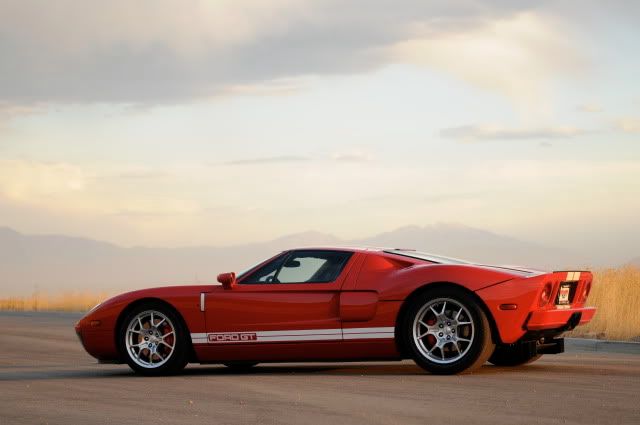
Moving from the Porsche to the GT, one is immediately struck by the exuberant and historically inspired design of the car, including the cockpit. The GT interior feels more airy than the Porsche, which is usually the case when comparing our big American cars made for big American roads and big American bottoms against small European cars made for small European roads. The outward view of the GT, however, is somewhat more pinched than that of the CGT, and the thick A pillars are significantly more present than those of the Porsche. However, I have never sat in the GT in isolation and thought it was hard to see out of. Nor have I felt a lack of confidence about where the car is in a corner; the outward visibility simply feels different and slightly less open by comparison. The ergonomics of the GT are fantastic; the shift lever is right where you want it, the pedals are easy to manipulate, and the long row of gauges are an aesthetic and functional homerun. True to the Le Mans heritage, the speedo is to the far right, canted toward the driver.
Press the red blast-off button, and the big V8 (ironically about 300cc smaller than the Porscheís V10) lights with a bark and then a rumble, and you are back home in the U S of A. Or maybe at Le Mans in 1966. Pull out of the neighborhood and let the fireworks begin. The clutch, of course, is a dream of simplicity compared to the Porsche. In this regard, the Ford seems like your most loyal bird dog or maybe your best buddy; you just know what heís gonna do every time, under fire or not. The GT is no more difficult to drive than a V8 Mustang. Itís just that this particular Ford is capable of blistering the tarmac at 212 MPH and looks like it could have just pulled off the Mulsanne straight. Whatís amazing is that the athletic GT can do all of this and more, yet it remains drama free. The driving experience is silky in comparison to the CGT. I am surprised that I can write that and still feel like Iím telling the truth. But I am.
2. ENGINES
Carrera GT
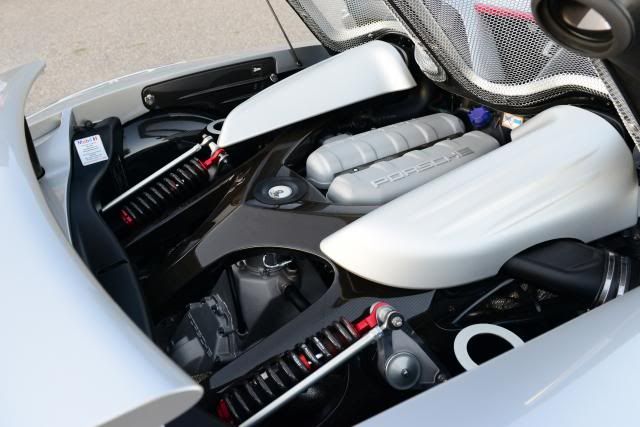
The CGT engine is far and away the most extroverted and charismatic engine Iíve ever experienced. I say this for three reasons: First, because of the race-car way the engine revs. Second, because of its explosive power delivery, and third, because of the glorious wail it emits.
A great deal of the CGTís fascinating engine dynamic comes from the fact that the V10 has so little rotational inertia. Iím not sure, but it seems like at least some of this is because of the CGTís Lilliputian clutch assembly and itís ten titanium connecting rods. With a ďnormalĒ car like the GT (and every other three pedal car I have owned) you accelerate away in first gear, and as you disengage to change gears, the revs will hold station for a moment because of the intertia of the rotating flywheel and clutch. If done properly, the engine speed matches gear speed as the next gear is engaged, and the result is as smooth as butter. Not in the CGT. The moment you let off the throttle in first gear and depress the stiff clutch, the revs fall off a cliff, all the way back to idle in the blink of an eye. The vehicle speed then zings the revs back up when the next gear is engaged. Most skilled drivers can easily match revs on the down shift, but I have never driven a car that has made me wonder about a technique for rev matching on the upshift.
Of course, the upside for that lack of inertia is that the CGT engine revs like a Banshee two-stroke demon from Hades with its pants on fire and ants in there too. It screams through the rev range with the alacrity a Formula 1 car. Really. I struggle to find words to describe the nutzo ferocity of this power plant, but let me give it a try: Imagine a 911 GT3, except a two-stroke version, on a cocktail of crack and nitro methane, then give it a squirt of NO2. To call it ďquickĒ is like calling the Pacific Ocean ďmoistĒ. The engine lacks just a bit of the low end grunt of the FGT, but it makes up for it with ferocious punch and flexibility from about 2600 RPM all the way to 8400. The engine of the Ferrari 458, which is simply terrific, should get clammy and pale in the presence of this Teutonic monster. The torrent of power immediately on tap throughout the range is inspiring and quite unlike any other car I know of. It is amazingly responsive and mashing of the throttle results in an immediate and gratifying catapult into the next zip code.
Anecdote 1: I picked the car up in person from Shelby in Jonesboro. The CGT will spend most of its life at about 4500 feet above sea level, and I always like driving at lower elevations because of the enhanced power. Knowing this might be my only chance to test its low altitude mojo, I took the miscreant out for a little bonding time in lovely Arkansas. I was of course, being quite cautious, as any gentleman would in an unfamiliar $400,000 car. After the oil was warm, I rolled into the throttle on a smooth, wide, inviting onramp. My ears were pinned back and that spine tingling banshee wail commenced to shake the pillars of heavens. However, before you could say ďSteve McQueenĒ the rump gave a lurid wiggle and the traction control light on the dash began scolding me. ďBut I vas een za secont geer, fo cryink owt lowd!Ē I responded apologetically. This is the first and only time in all of my driving experience that I have ever unintentionally spun the back tires of a car. This includes the 700 HP GT and my former 750 HP Kirkham Cobra. That bulbous little demon weighed 1800 pounds. I have since installed a new set of Pilot Super Sport tires on the CGT, which I understand have better sticktion than the OE tires. I still lack temerity to mat the throttle in either 1st or 2ND gear.
Anecdote 2: My 18 year-old gear head daughter (a Ford GT aficionado of the first order, who inherited a rare congenital disease from the paternal line known as Velocitosis Vulgaris) and I were out on a desert back road in the CGT. I found it requisite to dispatch a slower moving car, so I grabbed a lower gear and squeezed the throttle. We shot past the doddering obstacle in an explosion of speed and sound. She looked at me in honest amazement and said, ďI think this thing may pull as hard as the GT.Ē High praise indeed.
Finally, there is the otherworldly noise that the CGT makes when driven in anger. Most car guys will agree that the Carrera GT is the meanest sounding street car ever devised, and having experienced it repeatedly from the driverís seat, I heartily agree. My CGT happens to have a set of aftermarket pipes on it that I swear have super magical sound amplifiers built into them. If you havenít already done so, add ďhearing a Carrera GT at full song, in personĒ to your bucket list.
The Ford GT
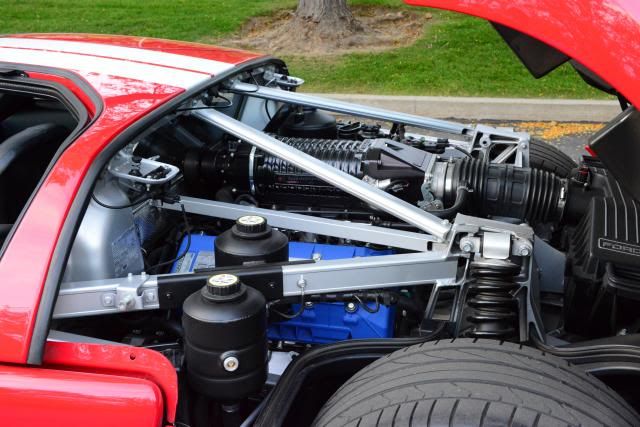
If you are an addict of stump pulling American torque, you will never be able to fully enjoy another exotic after you have driven a Ford GT. Compounded with the extra oomph obtained through an aftermarket tune and enhanced supercharger boost (either using a pulley/tune or, even better, a Whipple), a GT becomes one of the most accomplished thrust-meisters ever devised. Under wide open throttle, the GT has the ability to deliver astonishing propulsion without even breaking a sweat. It also delivers power in a decidedly less scary way than the Porsche. It will easily break the rear tires loose, but it just seem to do so with less of the zingy, insane violence of the CGT. Make no mistake, the GT lacks nothing in the power department vs. the Porsche. In fact, Iím very confident that the GT will easily best the CGT from 0-60, simply because you donít have to shift to second. However, I donít set much store on 0-60 times Ė its 5-100 that I enjoy. Even in that range, the power delivery of the GT is more linear and predictable than that of CGT. Iím not sure which is fastest, but either car will put your heart in your throat when you nail the loud pedal in 2nd gear.
While the high speed capability of the GT has become the stuff of legend, I would suggest that at least half of that magic is because the engine is capable of turning those tall gears with such commanding authority. If you want a power plant that produces chest-compressing power right out of the box, responds well to modifications, and is capable of propelling you without drama to a truly ballistic 200+ mph, look no further than this hand built, 32 valve, dual overhead cam, American masterpiece. It makes the Corvetteís pushrod V8 look Neanderthal.
WINNER: CGT. However, if you like the idea of home brewing a little extra thrust and turning a wrench now and then, itís the FGT all day long.
3. BUILD QUALITY
Carrera GT
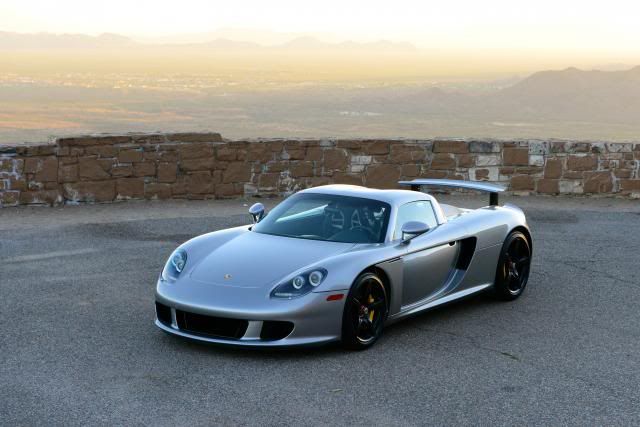
If ever there was a car that a man could stare at, wax, and then wax again, itís the Carrera GT. Itís simply a work of exquisite industrial design, flawlessly executed. The whole car has this special, bespoke feel to it, like a Holland and Holland double gun. I donít know if any car can ever really be worth as much as this thing cost, but there is comfort in knowing that it is an extraordinarily and unusually fine work of craftsmanship. Iíve never owned a car that is of equivalent quality, but Iíve had quite a few that were far worse. Herein lies one of the fascinating paradoxes of the Carrera GT: It looks like itís spun from pure, lovely silk, and every surface is pleasing to the touch and to the eye. Then you fire it up and nail the accelerator. Suddenly, in waltzes the evil cousin; the one who wants to scream at you as it tears your head off instead of quietly eating its tea and crumpets.
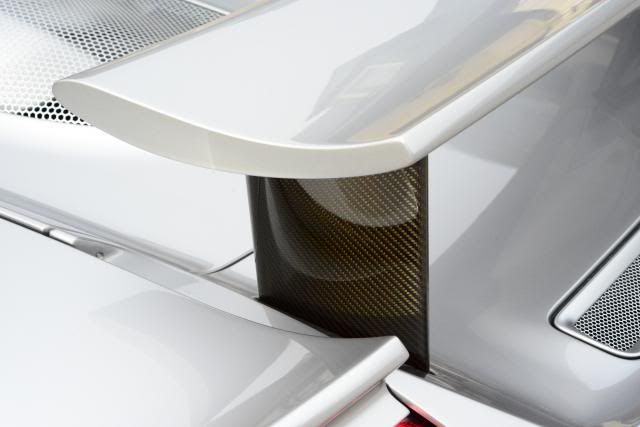
Ford GT

In the quality department, the GT has proven itself to be among the finest supercars Iíve owned. It arrived from the factory with a flawlessly smooth paint job, far superior to any Ferrari Iíve owned. After 17,000 miles, the car still looks, smells and drives like new. Beyond oil changes and half shaft bolts preventatively replaced, the car has never given me a problem. The aromatic leather covering the carbon fiber seats have held up perfectly, and Iíve had no gauge problems, no engine weirdness, no electrical spasms. Pretty remarkable for a car that has carried me to 210 mph and has also made the occasional trip to the market for (a few) groceries.
Winner: CGT, but for the money, it better win. In fact, it ought to tutor my kids and wash the dog for what it cost.
4. HANDLING
Iíve written before about my favorite Arizona canyon drive, down White Spar Road, through Peeples Valley and down Yarnell Hill (home of the recently tragic wildfire). I have used this road to compare all the cars Iíve owned, and it has given me a pretty decent baseline upon which to make a few judgments. I actually enjoy this environment much more than the race track, simply because I can drive easily within my limits and donít feel like Iím beating on the car quite as much as is required at the track. The road is plenty challenging, however, and it reveals a cars real world capabilities.
The Carrera GT
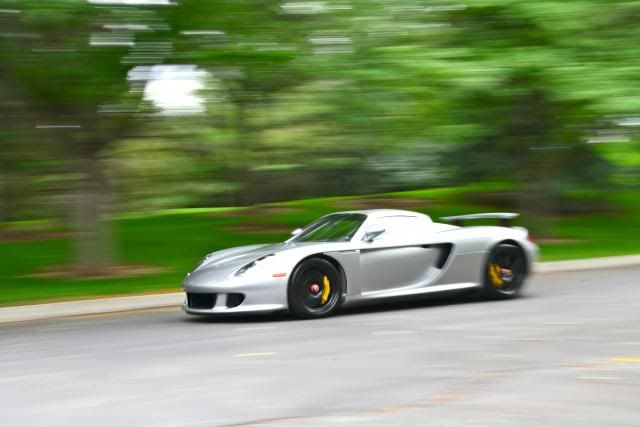
Earlier in this review, I made several comments about the Carrera GT being a thinly disguised race car. Accordingly, one must be willing to accept a few compromises when it comes to signal-to-signal city driving. Unsurprisingly, it is on the twisty mountain road where these peculiarities are utterly forgotten. Gear noise? What gear noise? Finicky clutch? Who needs 1st gear? The CGT is simple perfection in the canyon; the steering is transparent and immediate, there is virtually no body roll, and to exceed the carís cornering capability on public roads would be impossible, barring the flagrant onset of idiocy. The car tracks like a hog on rails and goes immediately and precisely where you point it. The feel of the massive carbon brakes is awesome and far superior to the 458. This responsiveness makes driving the car delightful. The communicative chassis, which seems to give too much information while clomping over expansion joints on the freeway, now shines. I feel absolutely confident carving through banked apexes, partly because of the outward visibility, but also because I know what the car is doing underneath me. Iím not previously familiar with the dynamics of a pushrod suspension, so I donít know if the brilliance of the handling is related to that configuration. I just know that it is superb, and driving the car in the proper environment is addictive. Piloting this car is an adventure, plain and simple. Wow.
Ford GT
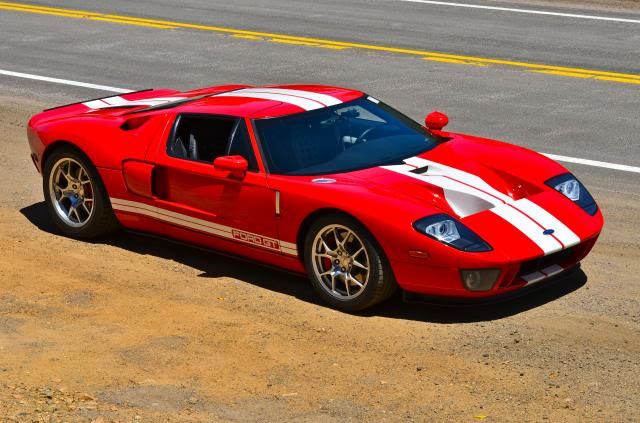
The GT is completely competent and feels quite at home in the canyon. However, the compromises that the GT does not make in general driving removes just a degree of sharpness from the experience in side-by-side comparison with the CGT. In fairness to the GT, Iím sure that if Ford engineers had been willing to make the GT ride like a milk wagon, they could have duplicated much of the hard wired handling responsiveness of the CGT. However, the balance of ride comfort and handling that they arrived at is perfectly suited to the carís mission. It would not be fair to criticize the GTís handling based soley on a comparison to the Porscheís. They were obviously designed with different priorities in mind. The GT remains one of the best canyon cars Iíve owned, and itís a fine day indeed when I get to take it through the paces of White Spar Road. I do wish that it had just a bit more steering feel.
Unlike the CGT, Iíve taken the GT to the track several times, and it is just as friendly and drama free at the track as it in on the street. I recently took the Ferrari 458 and the GT to the track to drive them back-to-back. To my huge surprise, I found that I felt much more comfortable and competent it the GT. It really is that good, and such an easy car to drive quickly and smoothly. Well balanced and generally unflappable is the way I would describe the handling of the GT.
Winner: Carrera GT. I do not know of its equal, including the track specialist Viper ACR.
5. STYLING
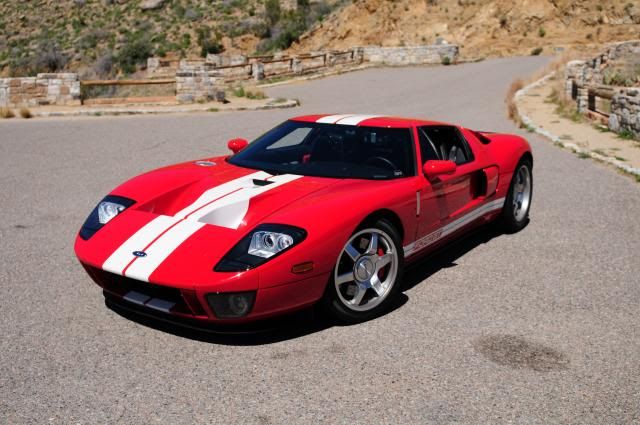
The topic of styling is so very subjective that itís probably a waste of time discussing it. However, here are a few observations. The GT is a low, wide bullet of a car, and is simply spectacular when itís on the road and viewed from another vehicle. Sometimes I ask my buddy to drive it while I follow just so I can see what it looks like on the road. Iím serious. The styling of the car has held up well over time, and we will never have to worry about it looking like last years model. To illustrate this point, consider the lowly Ferrari F430 compared to the fabulous 458. Will we still feel that way when the 458 is yesterdays model? In fact, I just looked at the pictures of the new 458 Speciale, and now all those guys who bought the standard 458 as the ultimate trophy of their success have a problem; its yesterdayís trophy. It doesnít seem like that will ever be a concern with the GT. It was inspiringly cool to start with, and they ainít gonna build any more of them. I was at the Miller Motorsport Museum last week, and resolved that the most beautiful car ever built was the diminutive and proportionally perfect GT40 Mark I. Right there with it, then, is the modern Ford GT. Iím so glad that I own one and that I get to go out to the garage and give it some love anytime I want to. Iíve met quite a few people who have never seen a GT until they saw mine, and many of these same folks will never see another.
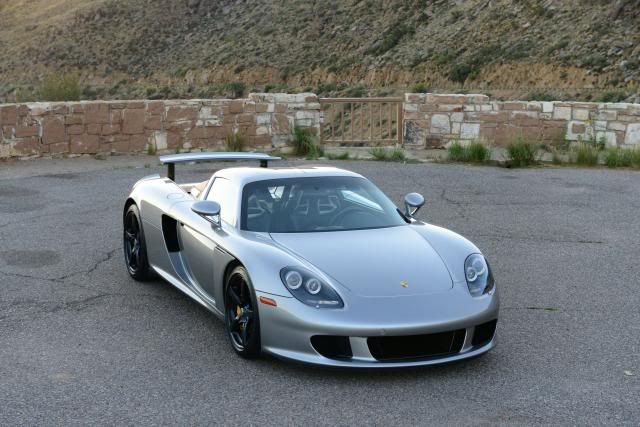
The Carrera GT isÖinteresting. I donít mean that sarcastically. Iíve found over and over again that the longer I look at the CGT, the more attractive it becomes. The shape of the car and its exquisite quality are fascinating in a way that ordinary cars never could be. Iím not sure I like the way the cab just sort of ďstopsĒ at the B pillar. However, I love the low nose and those super boss screen covered humps that sit over the engine air intakes. The deployable rear spoiler is pure autobahn coolness, and the carís low, wicked stance and big fat tires are pure Le Mans. The CGT is peculiar in the fact that the closer you get to the car, the more impressive it becomes. Itís the opposite of the Monet effect, where the pretty lady ainít quite so pretty when you see her up close. The finish and detail of the car are just so exquisite that you can only appreciate it fully by examining it while standing within 10 feet. The interior of the CGT is a little more refined and aesthetically pleasing than the GT, but each interior is consistent with the overall theme of the respective car in which it sits.
WINNER: FORD GT. The GT is the more attractive design. I have to say that in a whisper. If the CGT hears me, it may try to tear my head off.
CONCLUDING THOUGHTS
The Exotic Factor
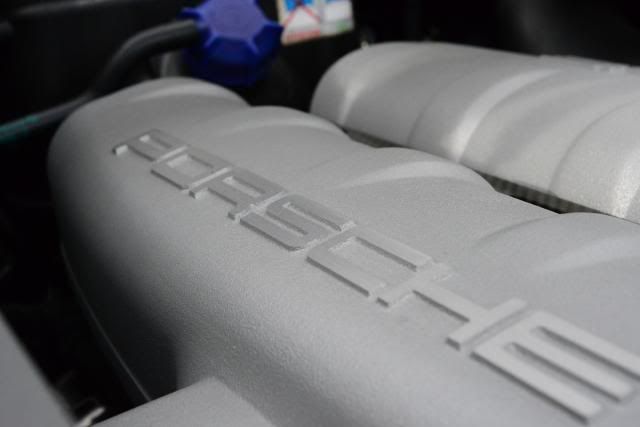
Both the CGT and the GT epitomize what most people would call ďexoticĒ cars. But have you ever stopped and thought about what that term actually means in this context? Websterís definition serves quite well: ďthat which is strikingly, excitingly, or mysteriously different". If one where to place either the GT or the CGT next to an emasculated Prius or anemic Corolla, one would have no trouble agreeing they are indeed ďstrikingly, excitingly different.Ē The next question is which is the more exotic between the Porsche and the Ford? In this case, the nod certainly has to go to the Porsche. With the extensive use of carbon fiber, the race-derived inboard suspension, and the unique driving dynamics (including the wee clutch and the lack of rotational intertia of the engine) the CGT is in a league of its own. Iíve never had the pleasure of driving a Mclaren F1, an F40 or and F50, but I would guess that the CGT has more in common with these cars than it does with the GT. However, if we agree that the CGT is ďstrikingly, excitingly or mysteriously differentĒ when compared with the average sports car, does that actually make it better? Could not the same have been said for the deplorable Delorean when it was released? Please stand back at a safe distance while I attempt to wrangle that dangerous questionÖ
First, More Miscellaneous Boring Thoughts
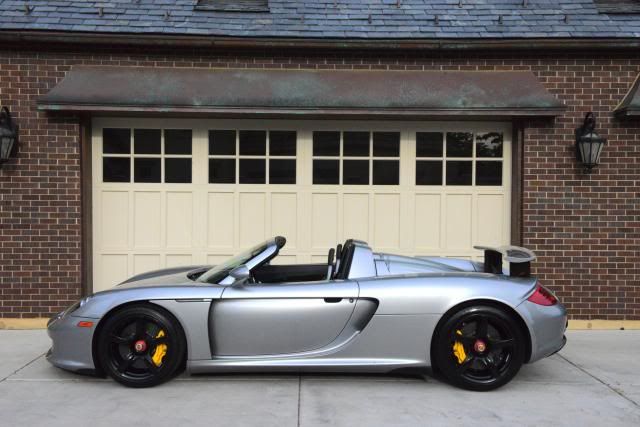
I generally hate open cars, simply because they are such a huge compromise to torsional rigidity. I suppose some guys would never even notice it, but one of my least favorite things in the world is to drive a convertible over a railroad crossing and feel the entire car shuddering around me. However, the great benefit of that spectacularly expensive carbon monocoque in the CGT is its resistance to twisting under load. Iím not sure how accurate they are, but several websites indicate that the CGT measures 26000 Nm/degree of deflection. For comparison sake, the 2005 Mustang convertible will flex a degree with only 9500 Nm applied. The closed roof GT measures an outstanding 27,100 Nm/degree, which makes the CGT pretty darn impressive by comparison. By the way, my bung-o-meter cannot detect the difference of 1,100 Nm/degree between the two cars. They both feel wiggle free when pounding over rough pavement.
Okay, so which is the better sports car?
For that one lonely reader who may still be with me at this point, I hope your job as a night watchman at the sprinkler factory is going well. Just for you, Iíll draw the following conclusions. First, of all the reviews I have written, this one seems like it compares cars that are the most dissimilar of any that I have owned. I can see now that the technical and engineering differences between these two cars and the resultant variance in prices (the MSRP of the Porsche is three times that of the GT) places them in different categories. The last comparison I wrote, comparing the spendy and glamorous Ferrari 458 with the GT was much easier. In that comparison, I chose the GT over the Ferrari, independent of price considerations. (Looking back on the 458, I am more confident than ever that I was right about that verdict.) The CGT, on the other hand, is engineered of such exotic materials, is of such an exotic design, and is so uncompromising in its pursuit of the race car-for-the-streets ethic, that it doesnít make for a fair comparison. GT vs. 458 was apples to apples. GT vs. CGT is apples to hand grenades.

Having said all that, I will answer the question that is most difficult but also most telling: If I could have only one, which would it be? That query is an agony, because I have so many memories in the GT and our little band of brothers is so supportive and entertaining. I love the racing history behind the GT, and the fact that the story and the car are so representative of everything I cherish about my beloved country. On the other hand, when I go out to the garage, itís hard to deny the addictive nature of the CGT driving experience. Driving the carbon fiber delinquent is an adventure every time, and the GT seems tame by comparison. Anyone can drive a GT reasonably well. The CGT does not suffer fools and requires total concentration. Yes, the clutch is a challenge, but it does get more intuitive with time and its nice to have a car that actually ďengagesĒ the driver with such intensity. They are both great cars, but they seem to have designed to accomplish different purposes. I therefore refuse to answer the question.
Just kidding. The other day, as I was blasting down the Canyon in the CGT, I was worrying over the ďwhich would I keepĒ question. I had an epiphany of sorts: If you were to put me at the top of a twisty road, or at the Nurburgring, or any other place that does not involve slogging from light to light, I would probably drive the CGT more often than the GT. It wouldnít be an easy choice, but the Porsche is just so wonderfully intense and responsive. Therefore, in the category of ďblow out the cobwebs and go for a spirited canyon drive after a crushing week at workĒ category, I can comfortably say that the gnarly CGT is my preference. I donít know that I have ever really felt such a pronounced appetite for the adventure of a curvy road as I do when sitting at the wheel of the CGT. However, how many of us live in a place where we have actual access to an open, twisty road? I am inclined to believe that of the 600 or so CGTs in the US, about three actually get used as they were designed. The rest sit in private collections and will spend little if any time burning up that expensive Michelin rubber. I can tell you without pause that if I lived in an area where the only roads where crowded surface streets and freeways, I could not own a CGT. It would be the most exquisite torture to own that car and not be able to deploy it, like a Steinway with a lock on the keyboard. Lovely to look at, but no fun to use.
The GT, on the other hand, is so docile in city traffic that I would take it out as readily as my Mercedes S550. I also love the fact that I can drive the GT out of the garage on any given day, and if I lived in Germany, I could hit an easy 200. On the way to pick up the milch.
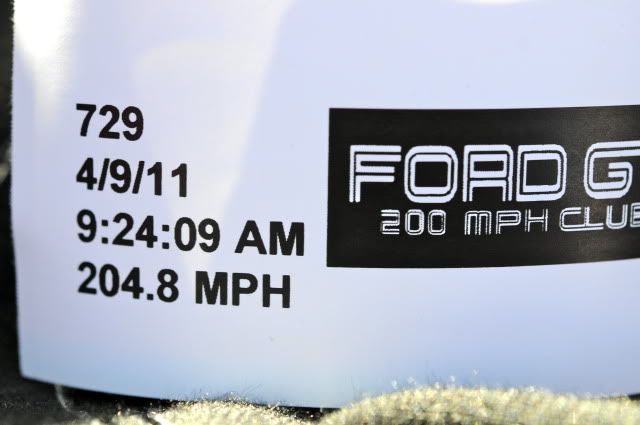
This much is clear: If I needed a jaw dropping sports car that could be tolerable in city driving and still scratch the speed itch when the opportunity presented itself, it wouldnít be a 458, or a Gallardo, or a GTR, or a Viper. I can think of no better choice than the fantastic Ford GT. City driving, cars and coffee driving, canyon driving, track driving: the Ford handles it all with aplomb. The only real hesitancy I have about driving the GT on a daily basis is the fact that itís hard to get into when someone parks next to you, the nose can be a bit low on parking ramps (the CGT, however, is much worse), and the car attracts so much attention that can be bit irritating unless you are in PR mode, which I sometimes am decidedly not. The bottom line is that the GT is superior to the Porsche in the sense that it can accomplish most of what the Porsche can do, at about 1/3 of the cost and with much less discomfort and drama. For many of us, that settles the question right there.
So there you have it. Give the Carrera GT a piece of twisting road and it will consume it like a co-ed on a Twinky. Put it in traffic and feels as frantic as a blind dog in a meat factory. The GT is more flexible and covers more of the usage spectrum, even if it does so in a slightly less manic and driver intensive way. You will simply have to decide which you like best. Donít you just love being a car guy?
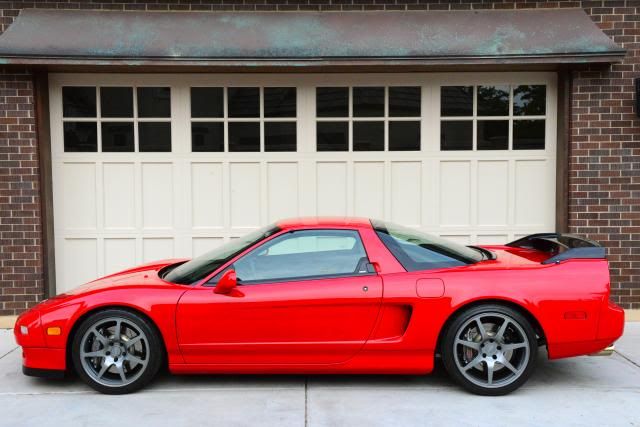
The lovely and incredibly responsive Zanardi NSX which I referenced in this review. The gold standard of balanced sports cars.

As a wise man once said, ďI've spent a bunch of money on cars. The rest has been wasted.Ē With that truism ringing in my head, I was recently fortunate to find an immaculate and virtually new Porsche Carrera GT. I bought the car from Shelby Smith (Elite Autos), an A+ purveyor of spotless GTs and other desirable exotics. The CGT is a car that has always fascinated me, but I was intimidated by its nosebleed price. When it became obvious that the cars were not getting any cheaper, compounded with the fact that this particular example came from the careful and very selective Shelby, I took the plunge. I have now driven it nearly one thousand miles. I warn the good reader in advance that this self-indulgent, vocabulary intensive review may result in a serious case of MEGO (scientific acronym for My Eyes Glazed Over). Remember, no one is forcing you to read this; if you hate all the talk, just nod and look at the pretty pictures.
Some of you who frequent the GT Forum know that this is not my first comparative review of the GT. This one, however, focuses on a contender that swings a very big stickÖand in this case itís made of carbon fiber. My standard pledge applies: Iíll try to be as honest and fair as I know how to be.
Intro: The Porsche Carrera GT.

Full disclosure: I have a fondness for Porsches, and the Carrera GT is my sixth car from the elves in Stuttgart. I presently have a 2013 Carrera 4S (7 speed manual) that is pure bliss to drive. My first real sports car was a 1984 911 Carrera, which I owned in college, and it sparked a long -term romance with these German icons. It also formed a foundation for how I judge and interpret the subsequent sports cars I have owned.
Ah, the lovely Carrera GT. Based on an aborted Le Mans effort, the body and structural monocoque is made almost entirely of carbon fiber. No cosmetic touches of carbon here, like the laughable $12,000 "carbon package" on the dash of my Ferrari 458. The car sports a pushrod suspension and inboard mounted shock absorbers, which is incredibly cool for a street car. The engine is a 5.7 Liter V-10, which was allegedly developed for Formula 1. The engine was then shelved for later use in either the Le Mans project, or as it turned out, for a limited run super car. Porsche built the CGT in very limited numbers: 1200 or so were assembled, and only half that number came to 'merica. Until I bought mine, I don't think Iíd ever actually seen one on the road. Produced at the same time as the Ford GT, the Carrera GT is also among the last of the true analogue supercars, with a manual transmission and relatively limited computer intervention.
Porsche did not name the Carrera GT by coincidence; it has obvious genetic ties to the revered 911 Carrera, including iconic design elements (the nose for example) and the intimacy of the interior and driving position. The car has a shallow dash, and the windscreen is relatively close to the driver. The moment you sit in the car, the bottom-hinged pedals, the design of the gauge cluster, and the placement of the wheel tell you that youíre in a Porsche. Itís just all about ten times more intense. Imagine taking three or four recent 911s, say, a turbo, a C2S, a 4.0 RS, and maybe even a GT3 Cup car. Further imagine putting these cars into a magical pressing device, and compacting them until a few tiny drops of highly enriched Teutonic mojo drips out the bottom. This is what the CGT is made of. For crying out loud, the whole car is made of carbon fiber, and then they strapped this manic, howling F1-derived V10 into the back of it.
Intro: The Ford GT (For non-owners and neophytes)

Ford built the GT to commemorate Ford's 100th anniversary, and production ran only in 2005 and 2006. During that time, just over 4000 were built. The car is based on the original GT40, variations of which famously dominated Le Mans from 1966-1969. Since production ended, the cars have been increasing in value and are widely recognized as a highly collectible modern exotic. A low mile Heritage car (Gulf themed, blue and orange) recently sold, including buyerís commission, for over $400,000. The GT boasts a wonderfully robust 5.4-liter, dual overhead cam V8 set under a super trick rear clamshell that opens to expose the entire power plant and rear structure of the car. In my humble opinion, the GT has one of the greatest American V8s ever built, and is capable of incredible feats of horsepower when modified. The Ford GT is unlike anything America has ever produced, with the obvious exception of the original GT40. It is the personification of American exuberance, amazing engineering prowess, inspired design, and just a touch of over-the-top excess. I seldom, if ever, see one on the road. It seems that they are becoming more rare as they are either crashed, exported overseas, or closeted away in private collections.
THE OVERALL DRIVING EXPERIENCE
I remember the first time I ever drove a GT. I said to myself ďSelf, this car is surprisingly docile and easy to driveĒ. When I first drove the CGT, I said to myself, ďSelf, this thing is surprisingly violent and difficult to driveĒ. First impressions arenít always right, but in this case, they were. Let me explain.
That #$%@ Clutch!

Letís get this out of the way first. Most of you have probably heard reference to the CGTís notorious clutch. Itís a tiny little multi plate affair made of carbon something. It weighs about as much as a pop tart. There is good news here and bad news. First the good: the clutch is quite ordinary and even pleasant to use while the car is in motion (i.e. gears 2-6). The bad news: 1st gear (and only from a dead stop), requires a special procedure that no other car demands. Imagine you are sitting at a stop light in heavy traffic. You are first at the line, because you got there first, just like a sport bike. The light turns green. Your instinct is to feather the throttle downward as you release the clutch, and leave the line smoothly. Bomp. The car bucks and then stalls! You curse. Your face turns red. You fumble. You cast a steely eye toward heaven. The Camry behind you almost tags you in the rump. Your next instinct is to fire the engine, give it even more throttle, and slip the clutch out. If you do this, the clutch will engage like an on/off switch, and you will lurch away from the line with all the grace of a 15 year-old with a learnerís permit. This, I am told, is the reason people burn their CGT clutch up in a few thousand miles and get to pay the price of a nice used car to have it replaced.
The proper method is simple but painfully counterintuitive: keep your foot away from the throttle, release the clutch slowly, and allow the anti-stall software to bump the revs as the car gets rolling. As soon as you are moving, you apply throttle and itís all quite smooth. But boy, does it feel slow. If you live way out in the country like I do, it doesnít matter how quickly you leave a dead stop, and it is an absolute no brainer to drive. Heavy urban traffic, however, is another story. One little trick is to time your start in advance of the green light, or to come to a ďrollingĒ stop at stop signs; if the car is even moving at 2 mph, the clutch is a breeze to release. Here is a word of warning to prospective CGT owner/drivers: if you like to do hole shots out of first gear, either find a different car or buy a six pack of Tilton carbon clutches and make good friends with your banker and your service guy. Iíve tried to figure out why Porsche would sacrifice first gear drivability is such a way. All I can deduce is that they felt quick intersection departures were less important than the ultra light weight and a lower center of gravity. Hmm, sounds suspiciously like a race car. Deal breaker? Not for me. But it might be for someone else.
A Race car in Designer Clothing

This is where I should digress and make a very important point to the uninitiated: the Carrera GT is certainly not for everyone, and Porsche meant it to be that way. If you look at all the glossy marketing pictures of the CGT and imagine that it will be a velvety, smooth grand touring car like a Mercedes SL, you are utterly and laughably mistaken. The only thing that the Carrera GT has in common with an SL is that they both ride on four wheels, and the only thing that separates the Carrera GT from a full-on race car is the lack of a fuel cell and a fire suppression system. Itís no surprise that it has built-in provisions for a race harness and deeply bolstered track seats, even if they are covered in fine leather.
First, there is the gear noise. In 1st and 2nd gears, there is pronounced sound of the cogs working, and in any gear, at about 2000 rpm, there is a rattlesnake resonance that is quite evident. Where it comes from, I donít know, but it feels like itís in the transaxle. Then thereís the ride, which is transparently communicative of virtually every road imperfection, no matter how tiny. The carbon monocoque has absolutely no flex. Accordingly, every ripple in the road is translated quite accurately through the super sensitive steering and the push rod suspension. As my Dad would say, you could drive over a dime in the CGT and tell the date stamped on it. The road noise is always there too, seemingly amplified by the chassis, and if your ears miss the sound of a every single freeway expansion joint, your bung-o-meter will be happy to send you the memo. Finally, there is the aforementioned race car clutch, the race car acceleration (more on that later) and the light rotational mass of the engine (later too).

I can certainly imagine that there were at least a few gold Rolex-toting trophy hunters back in Ď05 who bought the CGT, stalled it a few times, crashed it over a speed bump or two, and then escorted it quietly away, like the vulgar cousin who showed up unannounced for tea and crumpets. This is a hairy chested sports car, plain and simple, and I love it. Itís almost as if the design team said, ďokay, if we donít have to mass market this thing and keep a wide range of potential buyers happy, letís do it the way we would if the marketeers werenít looking.Ē
The engineers got the details right in so many ways. The outward visibility is pure 911 magic, with an unobstructed view of the road. I love the way this car feels from the driverís seat, even when itís not in motion. I donít think it has an equal in this regard, except maybe my inimitable Zanardi NSX. When you reach to the left of the steering column and twist the ignition, the tiny starter motor whirls like a LMP car and the V10 sparks to life immediately, at a high idle. From the first moment, this car tells you that it is looking for adventure. A Camry it is not.
The Ford GT

Moving from the Porsche to the GT, one is immediately struck by the exuberant and historically inspired design of the car, including the cockpit. The GT interior feels more airy than the Porsche, which is usually the case when comparing our big American cars made for big American roads and big American bottoms against small European cars made for small European roads. The outward view of the GT, however, is somewhat more pinched than that of the CGT, and the thick A pillars are significantly more present than those of the Porsche. However, I have never sat in the GT in isolation and thought it was hard to see out of. Nor have I felt a lack of confidence about where the car is in a corner; the outward visibility simply feels different and slightly less open by comparison. The ergonomics of the GT are fantastic; the shift lever is right where you want it, the pedals are easy to manipulate, and the long row of gauges are an aesthetic and functional homerun. True to the Le Mans heritage, the speedo is to the far right, canted toward the driver.
Press the red blast-off button, and the big V8 (ironically about 300cc smaller than the Porscheís V10) lights with a bark and then a rumble, and you are back home in the U S of A. Or maybe at Le Mans in 1966. Pull out of the neighborhood and let the fireworks begin. The clutch, of course, is a dream of simplicity compared to the Porsche. In this regard, the Ford seems like your most loyal bird dog or maybe your best buddy; you just know what heís gonna do every time, under fire or not. The GT is no more difficult to drive than a V8 Mustang. Itís just that this particular Ford is capable of blistering the tarmac at 212 MPH and looks like it could have just pulled off the Mulsanne straight. Whatís amazing is that the athletic GT can do all of this and more, yet it remains drama free. The driving experience is silky in comparison to the CGT. I am surprised that I can write that and still feel like Iím telling the truth. But I am.
2. ENGINES
Carrera GT

The CGT engine is far and away the most extroverted and charismatic engine Iíve ever experienced. I say this for three reasons: First, because of the race-car way the engine revs. Second, because of its explosive power delivery, and third, because of the glorious wail it emits.
A great deal of the CGTís fascinating engine dynamic comes from the fact that the V10 has so little rotational inertia. Iím not sure, but it seems like at least some of this is because of the CGTís Lilliputian clutch assembly and itís ten titanium connecting rods. With a ďnormalĒ car like the GT (and every other three pedal car I have owned) you accelerate away in first gear, and as you disengage to change gears, the revs will hold station for a moment because of the intertia of the rotating flywheel and clutch. If done properly, the engine speed matches gear speed as the next gear is engaged, and the result is as smooth as butter. Not in the CGT. The moment you let off the throttle in first gear and depress the stiff clutch, the revs fall off a cliff, all the way back to idle in the blink of an eye. The vehicle speed then zings the revs back up when the next gear is engaged. Most skilled drivers can easily match revs on the down shift, but I have never driven a car that has made me wonder about a technique for rev matching on the upshift.
Of course, the upside for that lack of inertia is that the CGT engine revs like a Banshee two-stroke demon from Hades with its pants on fire and ants in there too. It screams through the rev range with the alacrity a Formula 1 car. Really. I struggle to find words to describe the nutzo ferocity of this power plant, but let me give it a try: Imagine a 911 GT3, except a two-stroke version, on a cocktail of crack and nitro methane, then give it a squirt of NO2. To call it ďquickĒ is like calling the Pacific Ocean ďmoistĒ. The engine lacks just a bit of the low end grunt of the FGT, but it makes up for it with ferocious punch and flexibility from about 2600 RPM all the way to 8400. The engine of the Ferrari 458, which is simply terrific, should get clammy and pale in the presence of this Teutonic monster. The torrent of power immediately on tap throughout the range is inspiring and quite unlike any other car I know of. It is amazingly responsive and mashing of the throttle results in an immediate and gratifying catapult into the next zip code.
Anecdote 1: I picked the car up in person from Shelby in Jonesboro. The CGT will spend most of its life at about 4500 feet above sea level, and I always like driving at lower elevations because of the enhanced power. Knowing this might be my only chance to test its low altitude mojo, I took the miscreant out for a little bonding time in lovely Arkansas. I was of course, being quite cautious, as any gentleman would in an unfamiliar $400,000 car. After the oil was warm, I rolled into the throttle on a smooth, wide, inviting onramp. My ears were pinned back and that spine tingling banshee wail commenced to shake the pillars of heavens. However, before you could say ďSteve McQueenĒ the rump gave a lurid wiggle and the traction control light on the dash began scolding me. ďBut I vas een za secont geer, fo cryink owt lowd!Ē I responded apologetically. This is the first and only time in all of my driving experience that I have ever unintentionally spun the back tires of a car. This includes the 700 HP GT and my former 750 HP Kirkham Cobra. That bulbous little demon weighed 1800 pounds. I have since installed a new set of Pilot Super Sport tires on the CGT, which I understand have better sticktion than the OE tires. I still lack temerity to mat the throttle in either 1st or 2ND gear.
Anecdote 2: My 18 year-old gear head daughter (a Ford GT aficionado of the first order, who inherited a rare congenital disease from the paternal line known as Velocitosis Vulgaris) and I were out on a desert back road in the CGT. I found it requisite to dispatch a slower moving car, so I grabbed a lower gear and squeezed the throttle. We shot past the doddering obstacle in an explosion of speed and sound. She looked at me in honest amazement and said, ďI think this thing may pull as hard as the GT.Ē High praise indeed.
Finally, there is the otherworldly noise that the CGT makes when driven in anger. Most car guys will agree that the Carrera GT is the meanest sounding street car ever devised, and having experienced it repeatedly from the driverís seat, I heartily agree. My CGT happens to have a set of aftermarket pipes on it that I swear have super magical sound amplifiers built into them. If you havenít already done so, add ďhearing a Carrera GT at full song, in personĒ to your bucket list.
The Ford GT

If you are an addict of stump pulling American torque, you will never be able to fully enjoy another exotic after you have driven a Ford GT. Compounded with the extra oomph obtained through an aftermarket tune and enhanced supercharger boost (either using a pulley/tune or, even better, a Whipple), a GT becomes one of the most accomplished thrust-meisters ever devised. Under wide open throttle, the GT has the ability to deliver astonishing propulsion without even breaking a sweat. It also delivers power in a decidedly less scary way than the Porsche. It will easily break the rear tires loose, but it just seem to do so with less of the zingy, insane violence of the CGT. Make no mistake, the GT lacks nothing in the power department vs. the Porsche. In fact, Iím very confident that the GT will easily best the CGT from 0-60, simply because you donít have to shift to second. However, I donít set much store on 0-60 times Ė its 5-100 that I enjoy. Even in that range, the power delivery of the GT is more linear and predictable than that of CGT. Iím not sure which is fastest, but either car will put your heart in your throat when you nail the loud pedal in 2nd gear.
While the high speed capability of the GT has become the stuff of legend, I would suggest that at least half of that magic is because the engine is capable of turning those tall gears with such commanding authority. If you want a power plant that produces chest-compressing power right out of the box, responds well to modifications, and is capable of propelling you without drama to a truly ballistic 200+ mph, look no further than this hand built, 32 valve, dual overhead cam, American masterpiece. It makes the Corvetteís pushrod V8 look Neanderthal.
WINNER: CGT. However, if you like the idea of home brewing a little extra thrust and turning a wrench now and then, itís the FGT all day long.
3. BUILD QUALITY
Carrera GT

If ever there was a car that a man could stare at, wax, and then wax again, itís the Carrera GT. Itís simply a work of exquisite industrial design, flawlessly executed. The whole car has this special, bespoke feel to it, like a Holland and Holland double gun. I donít know if any car can ever really be worth as much as this thing cost, but there is comfort in knowing that it is an extraordinarily and unusually fine work of craftsmanship. Iíve never owned a car that is of equivalent quality, but Iíve had quite a few that were far worse. Herein lies one of the fascinating paradoxes of the Carrera GT: It looks like itís spun from pure, lovely silk, and every surface is pleasing to the touch and to the eye. Then you fire it up and nail the accelerator. Suddenly, in waltzes the evil cousin; the one who wants to scream at you as it tears your head off instead of quietly eating its tea and crumpets.

Ford GT

In the quality department, the GT has proven itself to be among the finest supercars Iíve owned. It arrived from the factory with a flawlessly smooth paint job, far superior to any Ferrari Iíve owned. After 17,000 miles, the car still looks, smells and drives like new. Beyond oil changes and half shaft bolts preventatively replaced, the car has never given me a problem. The aromatic leather covering the carbon fiber seats have held up perfectly, and Iíve had no gauge problems, no engine weirdness, no electrical spasms. Pretty remarkable for a car that has carried me to 210 mph and has also made the occasional trip to the market for (a few) groceries.
Winner: CGT, but for the money, it better win. In fact, it ought to tutor my kids and wash the dog for what it cost.
4. HANDLING
Iíve written before about my favorite Arizona canyon drive, down White Spar Road, through Peeples Valley and down Yarnell Hill (home of the recently tragic wildfire). I have used this road to compare all the cars Iíve owned, and it has given me a pretty decent baseline upon which to make a few judgments. I actually enjoy this environment much more than the race track, simply because I can drive easily within my limits and donít feel like Iím beating on the car quite as much as is required at the track. The road is plenty challenging, however, and it reveals a cars real world capabilities.
The Carrera GT

Earlier in this review, I made several comments about the Carrera GT being a thinly disguised race car. Accordingly, one must be willing to accept a few compromises when it comes to signal-to-signal city driving. Unsurprisingly, it is on the twisty mountain road where these peculiarities are utterly forgotten. Gear noise? What gear noise? Finicky clutch? Who needs 1st gear? The CGT is simple perfection in the canyon; the steering is transparent and immediate, there is virtually no body roll, and to exceed the carís cornering capability on public roads would be impossible, barring the flagrant onset of idiocy. The car tracks like a hog on rails and goes immediately and precisely where you point it. The feel of the massive carbon brakes is awesome and far superior to the 458. This responsiveness makes driving the car delightful. The communicative chassis, which seems to give too much information while clomping over expansion joints on the freeway, now shines. I feel absolutely confident carving through banked apexes, partly because of the outward visibility, but also because I know what the car is doing underneath me. Iím not previously familiar with the dynamics of a pushrod suspension, so I donít know if the brilliance of the handling is related to that configuration. I just know that it is superb, and driving the car in the proper environment is addictive. Piloting this car is an adventure, plain and simple. Wow.
Ford GT

The GT is completely competent and feels quite at home in the canyon. However, the compromises that the GT does not make in general driving removes just a degree of sharpness from the experience in side-by-side comparison with the CGT. In fairness to the GT, Iím sure that if Ford engineers had been willing to make the GT ride like a milk wagon, they could have duplicated much of the hard wired handling responsiveness of the CGT. However, the balance of ride comfort and handling that they arrived at is perfectly suited to the carís mission. It would not be fair to criticize the GTís handling based soley on a comparison to the Porscheís. They were obviously designed with different priorities in mind. The GT remains one of the best canyon cars Iíve owned, and itís a fine day indeed when I get to take it through the paces of White Spar Road. I do wish that it had just a bit more steering feel.
Unlike the CGT, Iíve taken the GT to the track several times, and it is just as friendly and drama free at the track as it in on the street. I recently took the Ferrari 458 and the GT to the track to drive them back-to-back. To my huge surprise, I found that I felt much more comfortable and competent it the GT. It really is that good, and such an easy car to drive quickly and smoothly. Well balanced and generally unflappable is the way I would describe the handling of the GT.
Winner: Carrera GT. I do not know of its equal, including the track specialist Viper ACR.
5. STYLING

The topic of styling is so very subjective that itís probably a waste of time discussing it. However, here are a few observations. The GT is a low, wide bullet of a car, and is simply spectacular when itís on the road and viewed from another vehicle. Sometimes I ask my buddy to drive it while I follow just so I can see what it looks like on the road. Iím serious. The styling of the car has held up well over time, and we will never have to worry about it looking like last years model. To illustrate this point, consider the lowly Ferrari F430 compared to the fabulous 458. Will we still feel that way when the 458 is yesterdays model? In fact, I just looked at the pictures of the new 458 Speciale, and now all those guys who bought the standard 458 as the ultimate trophy of their success have a problem; its yesterdayís trophy. It doesnít seem like that will ever be a concern with the GT. It was inspiringly cool to start with, and they ainít gonna build any more of them. I was at the Miller Motorsport Museum last week, and resolved that the most beautiful car ever built was the diminutive and proportionally perfect GT40 Mark I. Right there with it, then, is the modern Ford GT. Iím so glad that I own one and that I get to go out to the garage and give it some love anytime I want to. Iíve met quite a few people who have never seen a GT until they saw mine, and many of these same folks will never see another.

The Carrera GT isÖinteresting. I donít mean that sarcastically. Iíve found over and over again that the longer I look at the CGT, the more attractive it becomes. The shape of the car and its exquisite quality are fascinating in a way that ordinary cars never could be. Iím not sure I like the way the cab just sort of ďstopsĒ at the B pillar. However, I love the low nose and those super boss screen covered humps that sit over the engine air intakes. The deployable rear spoiler is pure autobahn coolness, and the carís low, wicked stance and big fat tires are pure Le Mans. The CGT is peculiar in the fact that the closer you get to the car, the more impressive it becomes. Itís the opposite of the Monet effect, where the pretty lady ainít quite so pretty when you see her up close. The finish and detail of the car are just so exquisite that you can only appreciate it fully by examining it while standing within 10 feet. The interior of the CGT is a little more refined and aesthetically pleasing than the GT, but each interior is consistent with the overall theme of the respective car in which it sits.
WINNER: FORD GT. The GT is the more attractive design. I have to say that in a whisper. If the CGT hears me, it may try to tear my head off.
CONCLUDING THOUGHTS
The Exotic Factor

Both the CGT and the GT epitomize what most people would call ďexoticĒ cars. But have you ever stopped and thought about what that term actually means in this context? Websterís definition serves quite well: ďthat which is strikingly, excitingly, or mysteriously different". If one where to place either the GT or the CGT next to an emasculated Prius or anemic Corolla, one would have no trouble agreeing they are indeed ďstrikingly, excitingly different.Ē The next question is which is the more exotic between the Porsche and the Ford? In this case, the nod certainly has to go to the Porsche. With the extensive use of carbon fiber, the race-derived inboard suspension, and the unique driving dynamics (including the wee clutch and the lack of rotational intertia of the engine) the CGT is in a league of its own. Iíve never had the pleasure of driving a Mclaren F1, an F40 or and F50, but I would guess that the CGT has more in common with these cars than it does with the GT. However, if we agree that the CGT is ďstrikingly, excitingly or mysteriously differentĒ when compared with the average sports car, does that actually make it better? Could not the same have been said for the deplorable Delorean when it was released? Please stand back at a safe distance while I attempt to wrangle that dangerous questionÖ
First, More Miscellaneous Boring Thoughts

I generally hate open cars, simply because they are such a huge compromise to torsional rigidity. I suppose some guys would never even notice it, but one of my least favorite things in the world is to drive a convertible over a railroad crossing and feel the entire car shuddering around me. However, the great benefit of that spectacularly expensive carbon monocoque in the CGT is its resistance to twisting under load. Iím not sure how accurate they are, but several websites indicate that the CGT measures 26000 Nm/degree of deflection. For comparison sake, the 2005 Mustang convertible will flex a degree with only 9500 Nm applied. The closed roof GT measures an outstanding 27,100 Nm/degree, which makes the CGT pretty darn impressive by comparison. By the way, my bung-o-meter cannot detect the difference of 1,100 Nm/degree between the two cars. They both feel wiggle free when pounding over rough pavement.
Okay, so which is the better sports car?
For that one lonely reader who may still be with me at this point, I hope your job as a night watchman at the sprinkler factory is going well. Just for you, Iíll draw the following conclusions. First, of all the reviews I have written, this one seems like it compares cars that are the most dissimilar of any that I have owned. I can see now that the technical and engineering differences between these two cars and the resultant variance in prices (the MSRP of the Porsche is three times that of the GT) places them in different categories. The last comparison I wrote, comparing the spendy and glamorous Ferrari 458 with the GT was much easier. In that comparison, I chose the GT over the Ferrari, independent of price considerations. (Looking back on the 458, I am more confident than ever that I was right about that verdict.) The CGT, on the other hand, is engineered of such exotic materials, is of such an exotic design, and is so uncompromising in its pursuit of the race car-for-the-streets ethic, that it doesnít make for a fair comparison. GT vs. 458 was apples to apples. GT vs. CGT is apples to hand grenades.

Having said all that, I will answer the question that is most difficult but also most telling: If I could have only one, which would it be? That query is an agony, because I have so many memories in the GT and our little band of brothers is so supportive and entertaining. I love the racing history behind the GT, and the fact that the story and the car are so representative of everything I cherish about my beloved country. On the other hand, when I go out to the garage, itís hard to deny the addictive nature of the CGT driving experience. Driving the carbon fiber delinquent is an adventure every time, and the GT seems tame by comparison. Anyone can drive a GT reasonably well. The CGT does not suffer fools and requires total concentration. Yes, the clutch is a challenge, but it does get more intuitive with time and its nice to have a car that actually ďengagesĒ the driver with such intensity. They are both great cars, but they seem to have designed to accomplish different purposes. I therefore refuse to answer the question.
Just kidding. The other day, as I was blasting down the Canyon in the CGT, I was worrying over the ďwhich would I keepĒ question. I had an epiphany of sorts: If you were to put me at the top of a twisty road, or at the Nurburgring, or any other place that does not involve slogging from light to light, I would probably drive the CGT more often than the GT. It wouldnít be an easy choice, but the Porsche is just so wonderfully intense and responsive. Therefore, in the category of ďblow out the cobwebs and go for a spirited canyon drive after a crushing week at workĒ category, I can comfortably say that the gnarly CGT is my preference. I donít know that I have ever really felt such a pronounced appetite for the adventure of a curvy road as I do when sitting at the wheel of the CGT. However, how many of us live in a place where we have actual access to an open, twisty road? I am inclined to believe that of the 600 or so CGTs in the US, about three actually get used as they were designed. The rest sit in private collections and will spend little if any time burning up that expensive Michelin rubber. I can tell you without pause that if I lived in an area where the only roads where crowded surface streets and freeways, I could not own a CGT. It would be the most exquisite torture to own that car and not be able to deploy it, like a Steinway with a lock on the keyboard. Lovely to look at, but no fun to use.
The GT, on the other hand, is so docile in city traffic that I would take it out as readily as my Mercedes S550. I also love the fact that I can drive the GT out of the garage on any given day, and if I lived in Germany, I could hit an easy 200. On the way to pick up the milch.

This much is clear: If I needed a jaw dropping sports car that could be tolerable in city driving and still scratch the speed itch when the opportunity presented itself, it wouldnít be a 458, or a Gallardo, or a GTR, or a Viper. I can think of no better choice than the fantastic Ford GT. City driving, cars and coffee driving, canyon driving, track driving: the Ford handles it all with aplomb. The only real hesitancy I have about driving the GT on a daily basis is the fact that itís hard to get into when someone parks next to you, the nose can be a bit low on parking ramps (the CGT, however, is much worse), and the car attracts so much attention that can be bit irritating unless you are in PR mode, which I sometimes am decidedly not. The bottom line is that the GT is superior to the Porsche in the sense that it can accomplish most of what the Porsche can do, at about 1/3 of the cost and with much less discomfort and drama. For many of us, that settles the question right there.
So there you have it. Give the Carrera GT a piece of twisting road and it will consume it like a co-ed on a Twinky. Put it in traffic and feels as frantic as a blind dog in a meat factory. The GT is more flexible and covers more of the usage spectrum, even if it does so in a slightly less manic and driver intensive way. You will simply have to decide which you like best. Donít you just love being a car guy?

The lovely and incredibly responsive Zanardi NSX which I referenced in this review. The gold standard of balanced sports cars.
#2
Beautifully written! I enjoyed reading this comparison even more than the EVO article on analogue supercars, and I recently told my friend that the EVO article was the most interesting sportscar article I've ever read.
Do you have links to the other comparisons you have done? I'd love to read them.
Do you have links to the other comparisons you have done? I'd love to read them.
#4
Racer
Join Date: Apr 2013
Location: Zug, Switzerland
Posts: 282
Likes: 0
Received 0 Likes
on
0 Posts
Agreed on the above two follow-on comments; fantastic write-up both in content and expression.
I have never been in a GT (recently bought a CGT); I know of the GT40 heritage (40 inches high). Jeremy Clarkson of Top Gear loved the GT for the combination of the qualities well noted above.
One slight difference in opinion I would point out: understand the bit about torsional rigidity (or the lack of it many open top cars). However, I massively prefer to be in an open top when its great weather out -- thats more important to me. Second, as noted, because they couldn't afford two versions of the CGT, they made it an open top and hence the extra 100kg weight addition from the prototype. Given the end result, I would take the open top any day. And, in the case of the CGT, I believe the car looks much better with the top off... It seems much more balanced and smooth (e.g., look at the two pictures you posted above). Thus, as much as I think the Ford GT looks pretty cool, I actually far prefer the CGT with the top off.
Anyhow, great write-up and totally agree with your general conclusions. I actually like using the public transportation system in London or Switzerland (or taxis) for the daily commute, etc.. Indeed, I never owned a car for 12 years in London. But only when I got to the beautiful roads of Europe did I fork out for the CGT (and could not be happier or more excited!). Just complete heaven.
I have never been in a GT (recently bought a CGT); I know of the GT40 heritage (40 inches high). Jeremy Clarkson of Top Gear loved the GT for the combination of the qualities well noted above.
One slight difference in opinion I would point out: understand the bit about torsional rigidity (or the lack of it many open top cars). However, I massively prefer to be in an open top when its great weather out -- thats more important to me. Second, as noted, because they couldn't afford two versions of the CGT, they made it an open top and hence the extra 100kg weight addition from the prototype. Given the end result, I would take the open top any day. And, in the case of the CGT, I believe the car looks much better with the top off... It seems much more balanced and smooth (e.g., look at the two pictures you posted above). Thus, as much as I think the Ford GT looks pretty cool, I actually far prefer the CGT with the top off.
Anyhow, great write-up and totally agree with your general conclusions. I actually like using the public transportation system in London or Switzerland (or taxis) for the daily commute, etc.. Indeed, I never owned a car for 12 years in London. But only when I got to the beautiful roads of Europe did I fork out for the CGT (and could not be happier or more excited!). Just complete heaven.
#5
Rennlist Member
W Mitty,
Great writeup! I've always had a fondness for the FGT and it's great to hear how the two compare. I'm afraid I've missed the boat on one (pricewise) but am not sure I'd have bought one anyway. I have some seat time in one and the one thing I negative I remember is one you mentioned about the A pillar - T H I C K! I felt like I was constantly ducking left and right to see around the thing. Otherwise, incredible car and one of the best cars I can think of to complement the cgt.
Great writeup! I've always had a fondness for the FGT and it's great to hear how the two compare. I'm afraid I've missed the boat on one (pricewise) but am not sure I'd have bought one anyway. I have some seat time in one and the one thing I negative I remember is one you mentioned about the A pillar - T H I C K! I felt like I was constantly ducking left and right to see around the thing. Otherwise, incredible car and one of the best cars I can think of to complement the cgt.
Last edited by bbs993tt; 08-29-2013 at 11:52 AM.
Trending Topics
#9
A thoroughly enjoyable read. As someone that's owned a CGT for almost 2 years and having read your other previous reviews of various sports cars, I could hardly wait to read your review of the CGT. It was everything I could have hoped for and more. I can assure you as you spend more time behind the wheel you will learn more and more about this car. It only gets better with time and there is SO much to explore. It never ceases to amaze.
Enjoy!
Enjoy!
#10
Burning Brakes
Mr. Mitty,
Circa: 2005
You are single, living in the city of your choice, the apartment of your choice, the daily driver of your choice (conservative, think Volvo), with a 2 car garage with exactly $448,000.00 in your bank account.
Balance pragmatism with exuberance...........
Given the 2 choices in this review...............what do you choose?
Circa: 2005
You are single, living in the city of your choice, the apartment of your choice, the daily driver of your choice (conservative, think Volvo), with a 2 car garage with exactly $448,000.00 in your bank account.
Balance pragmatism with exuberance...........
Given the 2 choices in this review...............what do you choose?
#11
Mr. Mitty,
Circa: 2005
You are single, living in the city of your choice, the apartment of your choice, the daily driver of your choice (conservative, think Volvo), with a 2 car garage with exactly $448,000.00 in your bank account.
Balance pragmatism with exuberance...........
Given the 2 choices in this review...............what do you choose?
Circa: 2005
You are single, living in the city of your choice, the apartment of your choice, the daily driver of your choice (conservative, think Volvo), with a 2 car garage with exactly $448,000.00 in your bank account.
Balance pragmatism with exuberance...........
Given the 2 choices in this review...............what do you choose?
#12
A thoroughly enjoyable read. As someone that's owned a CGT for almost 2 years and having read your other previous reviews of various sports cars, I could hardly wait to read your review of the CGT. It was everything I could have hoped for and more. I can assure you as you spend more time behind the wheel you will learn more and more about this car. It only gets better with time and there is SO much to explore. It never ceases to amaze.
Enjoy!
Enjoy!
#13
Burning Brakes
Best,
Bret.
#15
owners opinion 2:
as an owner for 2 years of two the finest examples of german craftmanship, i would like to compare the trabant convertible vs ze porsche cgt.
The cars were build only 82,2 km apart from each other in east Germany (Zwickau/Leipzig), saxonia.
the trabant is a late 1989 modell, one of the last of 3 million build by our ex-communist-dictatorship in the gdr/ddr, in Zwickau.
The cgt is a 2005 us model, 50.000km with its third clutch.
the body/safety
As with ze cgt, a close look was taken on the principle of lightweight production. The trabant is also known as ďRennpappeĒ/racing paper board or Plaste-Bomber/plastic bomber. The car body is fitted with elements made from glue and cottenwaste, which probably is even lighter than carbon.
In case of an accident, the trabant is known for behaving like a melon. The melon principle of exploding framework and the ignition of the tank in the very front of the motor helps avoiding minor injuries for all passengers (however severe pains cant be excluded).
The cgt in comparison is also lightweight, but the chances especially in germany are high your accident will take place on the autobahn while travelling around 300kmh.
trabant 1 cgt 1
huntability
Both cars sport some options here. However its much easier to shoot from the trabant in all directions. But the seats have a very upright position and if you try to change their position, its most likely that you dismantle them all together, so the seats will have no more connection to the carbody.
In the cgt you can more easily move the seat. so a wild pig fits perfectly in the cgt passenger seat.
I call it a draw again.
U S and A defense
We all know that the u.s. and a spy on us. germany i classified as an possible enemy, a friend of 3rd degree the nsa has said. I made the mistake to read in Wikipedia about osama and his friends. I am not able to prove not to have weapons of mass destruction, so an attack on me while driving by u. s. and a drones can be imminent at all times. The trabant is considerably slower, but also smaller. The drone pilot back in a cooled office container in Arizona might be offended me driving a fat car, or if he is into rennlist, he will see that it is a usa model cgt. Its impossible to say what car makes me a better target.
Itís a draw again.
Motor and sound
The cgt is unbeatable some might argue, BUT the trabant has a two stroke 26 horse power engine. And this engine needs no after sales attention. No new pipes. The engine itself will most likely be leaking air. Unfortunately my technical experience forbids to add a short movie here. The sound of a leaking twostroke can compete with a stradale. Itís a tone of a very aggressive 8 cylinder.
cgt 1 trabant 1
Conclusion
Both cars are well bred and perfect for the enthusiast. Its not possible to pick a winner.
photos: the trabant while hunting with anti drone technology head lights and a cgt with a young wild pig.
as an owner for 2 years of two the finest examples of german craftmanship, i would like to compare the trabant convertible vs ze porsche cgt.
The cars were build only 82,2 km apart from each other in east Germany (Zwickau/Leipzig), saxonia.
the trabant is a late 1989 modell, one of the last of 3 million build by our ex-communist-dictatorship in the gdr/ddr, in Zwickau.
The cgt is a 2005 us model, 50.000km with its third clutch.
the body/safety
As with ze cgt, a close look was taken on the principle of lightweight production. The trabant is also known as ďRennpappeĒ/racing paper board or Plaste-Bomber/plastic bomber. The car body is fitted with elements made from glue and cottenwaste, which probably is even lighter than carbon.
In case of an accident, the trabant is known for behaving like a melon. The melon principle of exploding framework and the ignition of the tank in the very front of the motor helps avoiding minor injuries for all passengers (however severe pains cant be excluded).
The cgt in comparison is also lightweight, but the chances especially in germany are high your accident will take place on the autobahn while travelling around 300kmh.
trabant 1 cgt 1
huntability
Both cars sport some options here. However its much easier to shoot from the trabant in all directions. But the seats have a very upright position and if you try to change their position, its most likely that you dismantle them all together, so the seats will have no more connection to the carbody.
In the cgt you can more easily move the seat. so a wild pig fits perfectly in the cgt passenger seat.
I call it a draw again.
U S and A defense
We all know that the u.s. and a spy on us. germany i classified as an possible enemy, a friend of 3rd degree the nsa has said. I made the mistake to read in Wikipedia about osama and his friends. I am not able to prove not to have weapons of mass destruction, so an attack on me while driving by u. s. and a drones can be imminent at all times. The trabant is considerably slower, but also smaller. The drone pilot back in a cooled office container in Arizona might be offended me driving a fat car, or if he is into rennlist, he will see that it is a usa model cgt. Its impossible to say what car makes me a better target.
Itís a draw again.
Motor and sound
The cgt is unbeatable some might argue, BUT the trabant has a two stroke 26 horse power engine. And this engine needs no after sales attention. No new pipes. The engine itself will most likely be leaking air. Unfortunately my technical experience forbids to add a short movie here. The sound of a leaking twostroke can compete with a stradale. Itís a tone of a very aggressive 8 cylinder.
cgt 1 trabant 1
Conclusion
Both cars are well bred and perfect for the enthusiast. Its not possible to pick a winner.
photos: the trabant while hunting with anti drone technology head lights and a cgt with a young wild pig.


